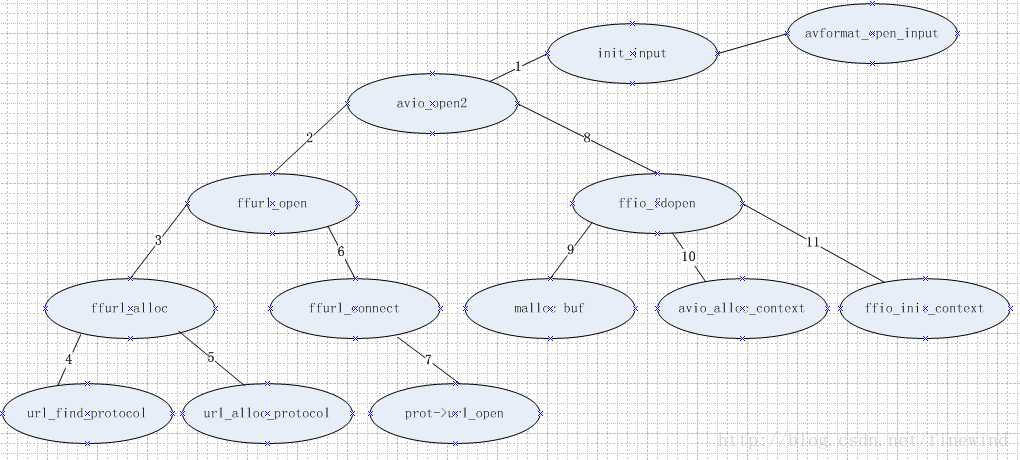FFMPEG之协议(文件)操作----AVIOContext, URLContext, URLProtocol
2021-06-09 13:03
标签:ioi 截断 write 地方 next off cpp sizeof 协议 版权声明:本文为博主原创文章,未经博主允许不得转载。 协议操作对象结构: 协议(文件)操作的顶层结构是AVIOContext,这个对象实现了带缓冲的读写操作;FFMPEG的输入对象AVFormat的pb字段指向一个AVIOContext。 AVIOContext的opaque实际指向一个URLContext对象,这个对象封装了协议对象及协议操作对象,其中prot指向具体的协议操作对象,priv_data指向具体的协议对象。 URLProtocol为协议操作对象,针对每种协议,会有一个这样的对象,每个协议操作对象和一个协议对象关联,比如,文件操作对象为ff_file_protocol,它关联的结构体是FileContext。 代码分析: 初始化AVIOFormat函数调用关系: 我们采用从底至上的方法分析源码。 URLProtocol是FFMPEG操作文件的结构(包括文件,网络数据流等等),包括open、close、read、write、seek等操作。 在在av_register_all()函数中,通过调用REGISTER_PROTOCOL()宏,所有的URLProtocol都保存在以first_protocol为链表头的链表中。 URLProtocol结构体的定义为(简化版,未完全列出所有成员): 以文件协议为例,ff_file_protocol变量定义为: 从中可以看出,.priv_data_size的值为sizeof(FileContext),即ff_file_protocol和FileContext想关联。
FileContext对象的定义为:

返回去看ff_file_protocol里的函数指针,以url_read成员为例,它指向file_read()函数,该函数的定义为:
- static int file_read(URLContext *h, unsigned char *buf, int size)
- {
- FileContext *c = h->priv_data;
- int r;
- size = FFMIN(size, c->blocksize);
- r = read(c->fd, buf, size);
- return (-1 == r)?AVERROR(errno):r;
- }
从代码可以看出:
1. 调用此函数时,URLContext的priv_data指向一个FileContext对象;
2. 该函数每次最大只读取FileContext.blocksize大小的数据。
从上面的代码中,还可发现一个重要的对象:URLContext,根据代码推测,这个对象的priv_data指向一个FileContext,下面来看看这个对象的定义及初始化:
定义:
- typedef struct URLContext {
- const AVClass *av_class; /**
- struct URLProtocol *prot;
- void *priv_data;
- char *filename; /**
- int flags;
- int max_packet_size; /**
- int is_streamed; /**
- int is_connected;
- AVIOInterruptCB interrupt_callback;
- int64_t rw_timeout; /**
- } URLContext;
注释已经很明了,接下来看看这个结构体的初始化,在url.h(URLContext定义的地方)文件中很容易发现有一个ffurl_open()函数,猜测这应该是个初始化函数,从
该函数的内容可知,它首先调用了ffurl_alloc()申请空间,然后调用了ffurl_connect()建立连接。因此我们的目标转向这两个函数
先看ffurl_alloc()函数,该函数先调用url_find_protocol()查找和输入文件名称对应的协议对象,然后调用url_alloc_for_protocol()申请空间。
从url_find_protocol()易知:filename和协议匹配的规则是finename的前缀名(本地文件被统一处理为file前缀)和协议的name字段所指向的字符串相等。
再看url_alloc_for_protocol()函数:
- static int url_alloc_for_protocol(URLContext **puc, struct URLProtocol *up,
- const char *filename, int flags,
- const AVIOInterruptCB *int_cb)
- {
- URLContext *uc;
- int err;
- // ...
- uc = av_mallocz(sizeof(URLContext) + strlen(filename) + 1); // 注意申请的空间大小
- if (!uc) {
- err = AVERROR(ENOMEM);
- goto fail;
- }
- uc->av_class = &ffurl_context_class;
- uc->filename = (char *)&uc[1]; // 指向uc+sizeof(URLContext)的低昂
- strcpy(uc->filename, filename);
- uc->prot = up;
- uc->flags = flags;
- uc->is_streamed = 0; /* default = not streamed */
- uc->max_packet_size = 0; /* default: stream file */
- if (up->priv_data_size) {
- uc->priv_data = av_mallocz(up->priv_data_size);
- if (!uc->priv_data) {
- err = AVERROR(ENOMEM);
- goto fail;
- }
- if (up->priv_data_class) {
- int proto_len= strlen(up->name);
- char *start = strchr(uc->filename, ‘,‘);
- *(const AVClass **)uc->priv_data = up->priv_data_class;
- av_opt_set_defaults(uc->priv_data);
- // ...
- }
- }
由上代码可以看出,URLContext的filename保存了输入文件名,prot字段保存了查找到的协议操作对象指针,flags由入参指定,is_streamed及max_packet_size默认值为0,
priv_data指向了一个由协议操作对象的priv_data_size指定大小的空间(考虑ff_file_protocol,即指向了一个sizeof(FileContext)大小的空间),且该空间的被初始化为0。
至此,URLContext的大部分内容已初始化,ffurl_alloc()工作已经完成,接着看ffurl_connect(),从代码易知,它调用了prot->url_open()函数打开协议,并设置了URLContext的
is_connected和is_streamed为1。
注意,av_opt_set_defaults(uc->priv_data)为为priv_data所指向的结构也进行了默认赋值操作,针对ff_file_protocol,赋值字段及值可参考file_options[]的定义:
- static const AVOption file_options[] = {
- { "truncate", "truncate existing files on write", offsetof(FileContext, trunc), AV_OPT_TYPE_INT, { .i64 = 1 }, 0, 1, AV_OPT_FLAG_ENCODING_PARAM },
- { "blocksize", "set I/O operation maximum block size", offsetof(FileContext, blocksize), AV_OPT_TYPE_INT, { .i64 = INT_MAX }, 1, INT_MAX, AV_OPT_FLAG_ENCODING_PARAM },
- { NULL }
- };
即,truncate字段赋值为1,blocksize字段赋值为INT_MAX。
最后看看file_open()函数,从代码容易看出,该函数打开了文件,并将文件句柄保存在FileContext的fd字段。并且,该函数还根据文件属性设置了FileContext的is_streamed的值。
URLContext再往上一层是AVIOContext,该结构体的定义为:
- typedef struct AVIOContext {
- const AVClass *av_class;
- unsigned char *buffer; /**
- int buffer_size; /**
- unsigned char *buf_ptr; /**
- unsigned char *buf_end; /**
- void *opaque; /**
- int (*read_packet)(void *opaque, uint8_t *buf, int buf_size); /* 指向ffurl_read() */
- int (*write_packet)(void *opaque, uint8_t *buf, int buf_size); /* 指向ffurl_write() */
- int64_t (*seek)(void *opaque, int64_t offset, int whence); /* 指向ffurl_seek() */
- int64_t pos; /**
- int must_flush; /**
- int eof_reached; /**
- int write_flag; /**
- int max_packet_size;
- unsigned long checksum;
- unsigned char *checksum_ptr;
- unsigned long (*update_checksum)(unsigned long checksum, const uint8_t *buf, unsigned int size);
- int error; /**
- int (*read_pause)(void *opaque, int pause);/
- int64_t (*read_seek)(void *opaque, int stream_index,
- int64_t timestamp, int flags);
- int seekable; // 是否可seek,0表示不可搜索
- int64_t maxsize;
- int direct;
- int64_t bytes_read;
- int seek_count;
- int writeout_count;
- int orig_buffer_size;
- }AVIOContext;
avio_open2()负责初始化AVIOContext,从代码易知,该函数首先调用ffurl_open()申请了一个URLContext对象并打开了文件。然后调用ffio_fdopen()申请一个AVIOContext对象并赋初值。
ffio_fdopen()先申请了一个读写缓冲buffer(结合文件协议,buffer大小为IO_BUFFER_SIZE),然后调用avio_alloc_context()赋值,注意ffurl_read,ffurl_write,ffurl_seek的地址作为入参被传入。
最终调用的是ffio_init_context赋值,结合入参可知:
AVIOContext.buffer指向申请到的buffer, AVIOContext.orig_buffer_size和AVIOContext.buffer_size值为buffer_size(I_BUFFER_SIZE),buf_ptr字段初始化为buffer的开始地址,opaque指向URLContext对象。
再关注下avio_read()函数:
- int avio_read(AVIOContext *s, unsigned char *buf, int size)
- {
- int len, size1;
- size1 = size;
- while (size > 0) {
- len = s->buf_end - s->buf_ptr;
- if (len > size)
- len = size;
- if (len == 0 || s->write_flag) {
- if((s->direct || size > s->buffer_size) && !s->update_checksum){
- if(s->read_packet)
- len = s->read_packet(s->opaque, buf, size);
- if (len
- /* do not modify buffer if EOF reached so that a seek back can
- be done without rereading data */
- s->eof_reached = 1;
- if(len
- s->error= len;
- break;
- } else {
- s->pos += len;
- s->bytes_read += len;
- size -= len;
- buf += len;
- s->buf_ptr = s->buffer;
- s->buf_end = s->buffer/* + len*/;
- }
- } else {
- fill_buffer(s);
- len = s->buf_end - s->buf_ptr;
- if (len == 0)
- break;
- }
- } else {
- memcpy(buf, s->buf_ptr, len);
- buf += len;
- s->buf_ptr += len;
- size -= len;
- }
- }
- if (size1 == size) {
- if (s->error) return s->error;
- if (url_feof(s)) return AVERROR_EOF;
- }
- return size1 - size;
- }
从代码易知,该函数实现了缓冲读写功能,即调用者传递的size比buffer_size大,则buffer_size的倍数部分会直接读取到buf,余数部分会首先读取buffer_size大小的数据到buffer(fill_buffer()函数),然后再拷贝到入参buf指向的地址中。
AVIOContext再往上一层是AVFormatContext对象,也是ffmpeg的顶层对象,AVFormatContext的pb字段指向一个AVIOContext对象。
FFMPEG之协议(文件)操作----AVIOContext, URLContext, URLProtocol
标签:ioi 截断 write 地方 next off cpp sizeof 协议
原文地址:http://www.cnblogs.com/meiwubiao/p/7300718.html
文章标题:FFMPEG之协议(文件)操作----AVIOContext, URLContext, URLProtocol
文章链接:http://soscw.com/essay/92688.html